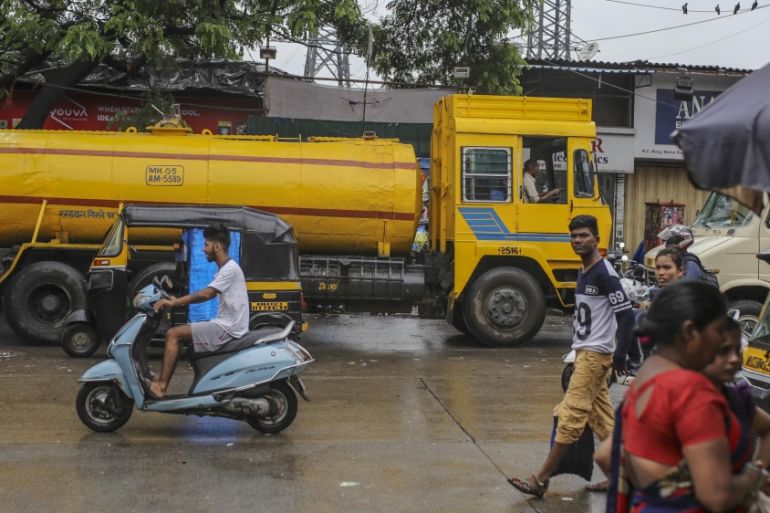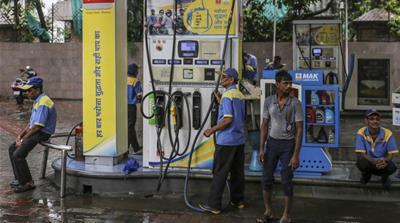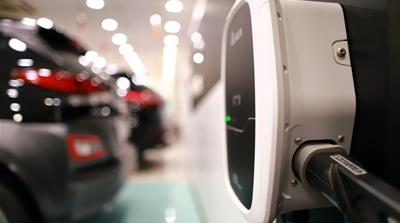Is it time for India to reduce its reliance on imported oil?
The recent spike in oil prices and a surge in inflation show how exposed India is to imported energy, analysts say.

New Delhi, India – The latest flare-up in tensions between Iran and the United States drove oil prices to four-month highs earlier this month, providing a stark reminder that India – which sources two-thirds of its oil from the Middle East – needs to reduce its dependence on crude to ensure its energy security, experts say.
Brent crude futures shot up to more than $71 per barrel on January 8, shortly after Iran fired missiles at military bases hosting US troops in Iraq. That was in retaliation for the US’s assassination of one of Iran’s top military commanders, Qassem Soleimani. Traders feared that an escalation in attacks could disrupt or even choke off oil supplies from the region to the rest of the world.
Keep reading
list of 4 items‘Triple spending’: Zimbabweans bear cost of changing to new ZiG currency
Boeing hit with 32 whistleblower claims, as dead worker’s case reviewed
US imposes new sanctions on Iran after attack on Israel
While those tensions have eased for now, it is clear that “India needs to diversify from oil”, Gagan Dixit, vice president of institutional equities research at Elara Capital, told Al Jazeera. “There’s no other way.”
India is the world’s third-largest consumer of oil after the US and China, according to the latest available figures from the US Energy Information Administration. And the International Energy Agency (IEA) says in a new report that India could take the top spot by the mid-2020s.
Most of that oil is imported.
From April to November last year, India imported 177.5 million metric tonnes of crude oil and petroleum products – or 84.7 percent of its consumption – worth $81bn, the latest government data shows.
That large imported fuel bill is adding to the pressure on consumers, who are struggling with rising inflation. Consumer prices grew at their fastest rate in five years in December, climbing by 7.35 percent, according to the latest government figures. Much of that growth was driven by a surge in vegetable prices.

India’s demand for oil is expected to continue growing and reach about 6 million barrels per day by 2024, up from 4.4 million barrels per day in 2017, representing an annual growth of 3.9 percent, much higher than the global average of 1.2 percent, the IEA said.
That makes India vulnerable to any risks that could disrupt oil supplies.
“India’s strong dependence on oil imports is expected to increase,” the IEA report says. With 65 percent of imports coming from the Middle East through the Strait of Hormuz, “the Indian economy is and will become even more exposed to risks of supply disruptions, geopolitical uncertainties and the volatility of oil prices,” the report said.
“Geopolitical volatility is embedded in oil,” said Anirban Mukherjee, a partner at the Boston Consulting Group. “We need to be prepared to deal with that because that is very difficult to predict and out of India’s control,” he told Al Jazeera.
Unconventional fuels
So how could India insulate itself from energy price shocks caused by events beyond its control?
Mukherjee suggests a two-pronged approach. At the national level, he says, New Delhi should ramp up its strategic oil reserves from the current quantity of 5.33 million metric tonnes (or 36.92 million barrels) that can fuel the country’s crude requirements for about 9.2 days. In addition, he suggests, India should also boost its reserves of unconventional fuels including shale oil and “really go after them in a concerted way”.
Elara Capital’s Dixit says another option for India is to increase the amount of natural gas it uses. “Growth of natural gas is the only way out,” he says.

At present, natural gas makes up about six percent of India’s energy mix, according to the IEA. Most of the rest comes from coal.
For the eight months ending November, India imported slightly more than half of its gas consumption of 42 billion cubic metres (bcm), according to government data.
India imports its gas from Qatar – which is not a member of the Organization of the Petroleum Exporting Countries – and from Russia, Australia and the US.
“These are more stable parts of the world and [that] reduces India’s dependency on the Middle East,” says Dixit.
India has also had a better record of discovering its own gas compared to oil.
According to the IEA, India has an estimated 1,340 bcm of relatively easy-to-extract natural gas reserves, and another 108 bcm of so-called “unconventional” methane reserves, which require more specialised equipment, techniques and money to extract.
While India aims to increase its natural gas use to 15 percent of the energy mix by 2030, to get there it needs to streamline its policies concerning the fuel, analysts say.
At the federal level, that means ensuring a single sales tax rate for gas, as opposed to the current rule that allows each state to set its own taxes. But equally importantly at the local level, city authorities need to make it easier for companies to navigate the myriad permits and processes they need to go through to lay pipes to get the gas to homes, says Dixit.
“That’s the most tedious task because it needs a pipeline to the end customer. It’s not like oil which you put in trucks and ship out,” he said.
Going electric
India can also cut back on some of its oil imports if it increases the number of electric vehicles on its roads. The biggest consumer of oil in the country is the transport sector, which used about 41 percent of the country’s oil in 2017, according to the IEA. Various government officials have said in the past that by 2030, 30 percent of the cars sold in India should be electric.
India can save on the equivalent of 55 million barrels of crude if 30 percent of the cars sold in that year are electric, according to an October report by the Council on Energy, Environment and Water (CEEW), a think-tank.

But, CEEW’s Chief Executive Officer Arunabha Ghosh says: “Energy security is not the same as energy independence.”
He told Al Jazeera it is important for India to secure reliable supplies of energy resources, including oil. But it also needs to ensure the oil it is buying has a safe passage through maritime channels.
Ghosh also stressed the need for India to have more solar panels and develop the critical minerals needed for batteries to store power – something that is crucial for ensuring steady supplies of electricity from renewable sources that can fluctuate widely.
India also needs to make its electricity grids more stable, Ghosh said.
Policy reforms are also needed. Among them, global institutions must ensure that high-energy consumers such as India and China have a say in policy decisions, he said.
“This has to be the strategy as India increases its integration into global energy markets,” Ghosh said. “Each element needs work today and more work tomorrow even as we shift towards a cleaner energy mix.”